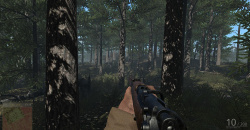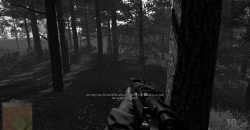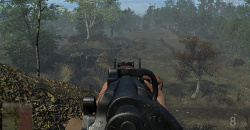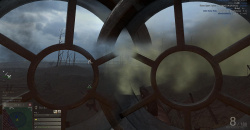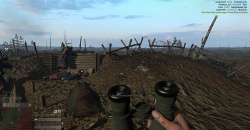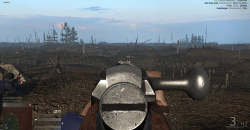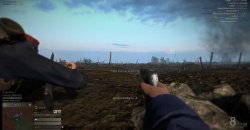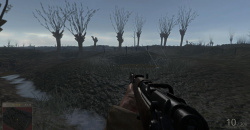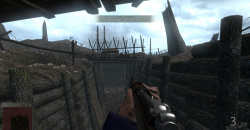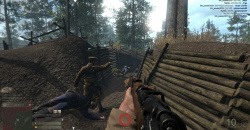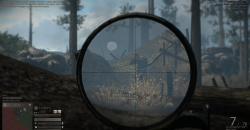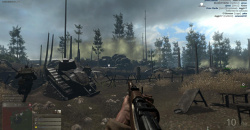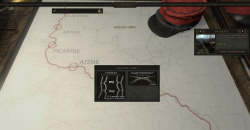If you ever want to find a first-person-shooter that takes place during World War II, the pool of available options is vast and deep – there's more than enough of them in the Medal of Honor and Call of Duty series alone. This makes it all the more curious that there are so few video game adapations of the epic conflict that preceded it. Dutch developers Blackmill Games have done their part and stepped up, and their World War I FPS Verdun is an attempt to fill that gaping hole in the market. For over a year, players were able to take to the trenches in Early Access, but Verdun finally went over the top this past April, and it's this full version that we played. Keep reading to find out what we thought.
Crawling Through the Muck In the annals of history, the Battle of Verdun, where the Germans launched an offensive on French forces stationed around the town of the same name, is remembered as one of the darkest chapters of the First World War. It was the first of the great battles of attrition that would define the latter years of the war on the Western Front, with well over 700,000 French and German soldiers killed or wounded. The battle was characterized by "static warfare", long periods of time where the two armies would stay put in their respective trenches, while at the same time trying to weaken the enemy forces with artillery barrages, gas attacks, and night-time forays to place land mines in no-man's land. The trenches themselves were protected by sprawling and complex tunnel systems below the surface and miles and miles or barbed wire above.
The Battle of Verdun serves as the backdrop for the game of the same name, where players can relive the harsh nature of war in the trenches online with other players – there is no single-player campaign in Verdun. There are a total of six maps, all based on the historic frontlines such as those in Flanders, Artois, and the Argonne. While each map has its own weather conditions, most of the time you'll be trudging through muddy trenches, running across bombed-out fields, and storming defensive positions bristling with barbed wire.
These legendary battelgrounds serve as the setting for two distinct game modes available in Verdun. In classic Deathmatch Mode, it's every man for himself, and the soldier with the most kills is the winner. This mode's simple premise makes it an ideal place to start for new players who stil need to familiarize themselves with the game's overall feel, the weapons available, and the various maps. The controls are pretty intuitive, and even special keyboard layouts are easy to learn.
The real heart and soul of Verdun, however, is "Frontline Mode", where two teams face each other across no-man's land, each team accomodating up to 16 players divided into four squads of four (32 total). Each team controls a series of positions to fortify and defend, and the goal is to capture the defensive positions belonging to the opposing team, taking and holding as much ground as possible and pushing them to the edge of the battlefield. Each attack on a sector of trench is automatically met with a counterattack, which, if successful, allows that team to gain ground. If it's not, they'll have to fall back and give up that position. This can lead to a situation where the two sides' forces are evenly matched as they take and re-take the same bitterly contested position for a good chunk of the game time.
Death Lurks 'Round Every Corner Like in other military shooters, troops in Verdun are divided into different classes depending on squad type (Recon, Assault, Rifle). Classes may include scouts, ordinary riflemen, marksmen, NCOs, machine gunners, etc., each with their own particular weapons and skills. While playing as a rifleman is all about finding the right balance between attack and defense, as a marksman you'll be tasked with fending off enemy attacks on the surface from a safe distance. Squad leaders have a special role in that instead of a rifle, they have binoculars, which they can use to observe the enemy's position, identify potential weaknesses, and call in artillery, air support, or gas attacks. There are several kinds of gas attacks available, depending on your level: tear gas, mustard gas, chlorine, and phosgene; they can be identified not only by their color, but also by the effect they have. A tear gas attack will cause the screen to go blurry, while a deadly chlorine attack will slowly turn the screen black. If you don't want to end up a faceless casualty of chemical warfare, there's a key to equip/unequip your gas mask, which will protect you from these poisonous substances.
But it's not just gas attacks and enemy soldiers you'll have to watch out for in Verdun – the limits of the battlefield can also be very dangerous. If you so much as step outside of the green markings indicating the edges of the map (some of which are pretty compact to begin with), you'll be counted a deserter; and if you don't return to the designated battlefield within five seconds, you'll face summary execution. The same thing happens if your squad doesn't take the enemy trench fast enough – you only get 30 seconds to retreat back to your own lines, or be shot as a deserter.
Teamwork is extremely important if you want to win matches in Verdun. It's also a good idea to proceed carefully and not forget to use cover. If you try to sprint over no-man's land towards the enemy, you're going to go down in a hail of bullets – one or two hits, and you're dead. If you want to stay alive a little bit longer, you can hunker down in one of the massive artillery craters that cover the map, hide behind sandbags, or creep through tall grass. If you do catch a bullet with your name on it, your teammates serve as a sort of mobile respawn point. It can be a bit jarring, though, when a fallen comrade suddenly pops up beside you out of thin air.
For each match you complete, you get an allotment of "career points", which you can use to unlock new weapons, or upgrade the weapons you already have. For example, you can add a bayonet for use in close combat, a scope for better shots at a distance, or a larger magazine to give you more firepower. There are a total of 21 firearms you can unlock, all of them modeled after historical weapons with great attention to detail.
Old Scenery, Old Technology In terms of graphics, Verdun does come off a bit dated when you compare it to other FPS games that have been released recently. While detailed weapons models, accurate period uniforms, and battle-scarred environments do lend an air of authenticity, the clunky animations and middling character models and effects tend to leave a pretty underwhelming impression. With the kind of technology that's available nowadays, the developers could have included mud as a deformable element like in Spintires, where it would show the effects of being bombarded by grenades and bullets, influencing the evironment and thus the gameplay itself. Unfortunately the brown muck in Verdun remains as static as the other elements that make up the environment – sandbags, boxes, wooden barricades.
On the other hand, the sound design is pretty great. Of course, Verdun doesn't quite reach the crystal-clear sound quality of one of the Battlefield games, but authentic weapons sounds and powerful explosions get the job done nicely. There's music, but only in the menu screen, where it's played by an antique phonograph record player – fitting, considering the setting.








